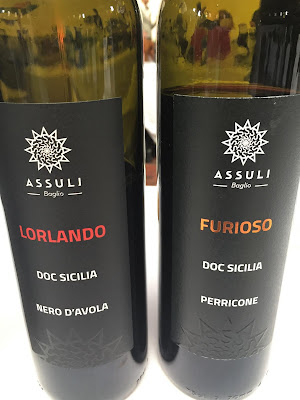As we start to wrap up some of these last weeks of summer
I wanted to share a couple wines I recently tasted before I start to
really shift my focus to reds. Although I enjoy both reds and whites
all year long
I do lean towards rose’ and whites in the warmer weather and reds once
the cool weather starts to hit. Today’s pick is a pinot grigio and a schiava, a lighter style red perfect for those craving reds in the warmer months.
The Winery ~ Nals Margreid
This was my first exposure to the wines of Nals Margreid
and like many others in the Alto Adige they are a cooperative of about
140 growers. This is very typical to see cooperatives as about 80% of
the production comes from coops. The terrain of this region is very
mountainous and so the growers all own smaller plots of land.
Nals Margreid is a merger that took place in 1985 between The Cellars Nalles established in 1932 and Magre Niclara established in 1954. Their growers span from Nals in the north located between Bozen and Merano to Margreid
in the south. The grapes are sourced from almost 400 acres and with
such a diversity of soils and microclimates coming from 14 winegrowing
areas Nals Margreid produces a large variety of wines.
The
overall climate of this region receives around 300 days of sunshine a
year with diurnal temperatures fluctuating degrees between day and
night, ideal conditions. The vineyards receive the cool climate from
the Alps in the north to the Mediterranean temperatures of the south.
The Grapes ~ Schiava & Pinot Grigio
Of course everyone knows pinot grigio, but seeking out the quality pinot grigio is always the chore. This grape is the 2nd
most widely planted grape in Alto Adige. The whites take the lead in
this region at 60% with pinot grigio leading the pack with others
including sauvignon blanc, gewurztraminer, pinot bianco and chardonnay. Pinot grigio produces wines that are clean, crisp with aromatic notes.
Schiava
is always one of my selections when someone asks me for selections on
lighter style reds to drink in the summer. It’s the most commonly
planted grape of the Alto Adige. It produces wines that are lighter in
body and color that are rather low in tannin, but with a refreshing
acidity. Notes of juicy strawberries and almond. It is best slightly
chilled. It is also known as vernatsch stemming from the latin word vernalucus meaning native, as it is native to the Alto Adige. Schiava leads the pack with lagrein for red grapes in the Alto Adige taking up 60% of the vineyards.
The Wine
Both of these wines are sourced from particular vineyard sites due to their particular characteristics. Their winemaker Harald Schraffl considers these vineyards “exceptional parcels”.
 2017 Nals Margreid Pinot Grigio Punggl – Named after the vineyard, Punggl, in the southern point of their territory these grapes come from 80+ year old vines. The wine spends 8 months in big
oak, not something you see as the norm with a wine like pinot grigio.
The grapes are grown in clay soils resulting in a wine that was round
and soft, but crisp with notes of apples and pairs. I preferred the pinot grigio over their Sirmian Pinot Bianco. SRP $20.
2017 Nals Margreid Pinot Grigio Punggl – Named after the vineyard, Punggl, in the southern point of their territory these grapes come from 80+ year old vines. The wine spends 8 months in big
oak, not something you see as the norm with a wine like pinot grigio.
The grapes are grown in clay soils resulting in a wine that was round
and soft, but crisp with notes of apples and pairs. I preferred the pinot grigio over their Sirmian Pinot Bianco. SRP $20.  2018 Nals Margreid Schiava Galea – Made from the schiava grape, also known as vernatsch. These grapes are grown on 100+ year old vines in the St. Magdalena vineyard on the northeastern tip of their territory. The schiava
spends 8 months in big oak. A lighter bodied wine with beautiful
fruit displaying cherries and raspberries. Nice acid and rather well
balanced with a little spice and vanilla notes. SRP $23. These were my
two selections from the lineup of Nals Margreid that I tried, but the schiava was my top pick.
2018 Nals Margreid Schiava Galea – Made from the schiava grape, also known as vernatsch. These grapes are grown on 100+ year old vines in the St. Magdalena vineyard on the northeastern tip of their territory. The schiava
spends 8 months in big oak. A lighter bodied wine with beautiful
fruit displaying cherries and raspberries. Nice acid and rather well
balanced with a little spice and vanilla notes. SRP $23. These were my
two selections from the lineup of Nals Margreid that I tried, but the schiava was my top pick. Fun Fact: The Alto Adige produces 10% of Europe’s apple production.





